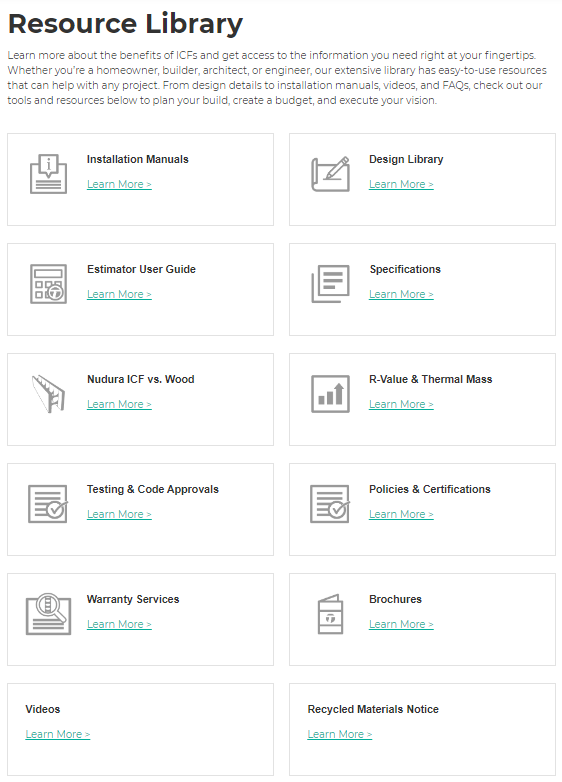
- Products
- Why Nudura
- Nudura Project Applications
- Training Academy
- Resources
- Company
Understanding ICFs
Most misconceptions about using Insulated Concrete Forms (ICFs) come from being unfamiliar with the method of construction, how to incorporate them into a design and how to install them in the field.
Design professionals and builders will need to react to the demands of the owners who request more environmentally conscious products and/or practices rather than settling for what has always been done. A building designed and constructed using ICFs will have a smaller environmental footprint than a traditional CMU or wood-frame building while being safer and more durable.
Plus, ICF structures have the same design versatility as other building methods so you don’t have to sacrifice aesthetics for performance. ICF construction is highly adaptive and not limited to any building format or architectural style, therefore their use in unique home or buildings is only limited by one’s imagination.
Once the construction industry approaches the use of ICFs from this perspective for the built environment, it's easy to see their many distinct advantages. Let's take a look at a few ways you can draft and plan for an ICF construction, choose your materials, reduce waste and be more cost-effective in the process.
Basic Principles for Drafting With ICF
Whether drafting from scratch or converting conventional building plans to ICF, resources are available to help guide best practices for a variety of building types. If you are converting wood and steel buildings to concrete, NRMCA's Design Assistance Program offers a great free resource to help you understand more about the process.
Here are a few things to consider which will guide ICF product selection.
- Know the dimensions of your ICF options and the application locations.
In ICF construction, there are different lengths, heights, and thicknesses for the inboard and outboard insulated form panels, as well as varying distances between the two layers of foam to accommodate for the concrete core. Therefore, it's important to know the performance values specified and structural requirements in order to choose the appropriate panel dimensions. Most manufacturers offer this type of information to ease product selection and application. Then, with the full dimensions of the building itself and where the ICFs are going to be used, drafts can be made to meet those specifications, resulting in a quicker building process and less material waste. - Understand the ICF interaction points with other elements.
Knowing how ICF walls can and will connect with other building elements such as flooring, roofing and other structural systems is important to establish in the planning stages. These interfaces must be air and watertight so material compatibility must be considered during product selection.
Incorporating ICFs in Drawings
It's important to realize that fractions will often be involved in optimal dimensions. In standard foundations, fractions would usually be soft-rounded out, but with ICF, allowing the manufacturer specs to take precedence will optimize the building process and reduce product waste.

The image above shows the ICF block information that most manufacturers offer. Drafting using the manufacturer-supplied measurements will help you maximize the efficiency of your building.
Typically, there will be straight, corner, and angled forms, as well as forms that can allow for brick-ledges, taper-top and are adaptable for radius walls. Straight and 90-degree forms are the most important and most used options as they will be used repetitively throughout construction. ICFs are also available in different heights, lengths, panel thickness and foam density type and can accommodate varying concrete core thicknesses. Should a dimension requirement not suit the typical measurements of a manufactured form, the form can typically be customized or altered on-site for the specific situation.
For example, a 6” core wall can transition to an 8” core wall at a corner by creating a hybrid corner using both a 6” and an 8” corner form combined by using a portion of each form. As with any non-manufactured or any other altered ICF product, some temporary blocking and reinforcement will be required until the concrete sets.
When incorporating ICFs in the drawings, note both the inboard and outboard dimensions of the ICF corners as these are usually the starting points for each wall segment. Typically, an ICF plan should be drafted as it is built, starting from the corners and moving inwards. Each wall segment will make use of the short side of a corner form and a long end of a corner form on the opposite end. Straight forms are infilled towards the center until it reaches the center-most portion of the wall, keeping in mind the corners can be spaced appropriately from one another to allow for the manufacturer's recommended increments to minimize waste.
Should the wall segment not match up with the optimal design using the manufacturer's suggestion, the simple use of a “stack joint” or vertical seam will be sufficient. Temporary reinforcement will be required until the concrete sets and the performance of the ICF wall will not be affected, (see image below).

This drawing above is an example of an ICF specific layout which can be used by the installer to establish the building footprint. ICF segments have been identified along with indication as to which forms to cut, where to cut the form and the required form dimension after cutting. Where required, a “Stack Joint” has been called out should the segment dimension not fit within the manufacturer’s optimal increments. Corners have been darkened as a visual reference to easily identify the long and the short sides of each corner. Having a long and short side of opposing corners facing each other will create a “bricking effect” where alternating rows upwards essentially lock in the lower row with the row above and avoid vertical seams to be atop one another.
ICFs Will Support Many Design Requirements and Aesthetics


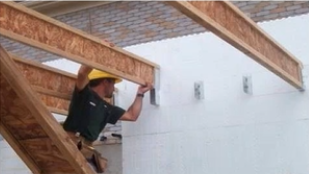
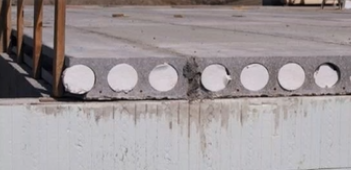
ICF construction can accommodate a wide variety of connection points ranging from on-ground slab interaction points, wooden open web joists, dimensional lumber, engineered wooden floor systems, hollow core concrete, composite concrete flooring, steel open web joists, wooden roof connections, steel roof connections, parapets, brick veneer, etc. The image above illustrates just a few different types of floor systems that are capable with ICF.
For internally supported flooring systems, ICFs provide a monolithic vertical wall from the top of the footing up to the underside of the roof without interruption of the inboard or outboard insulation. ICF construction minimizes any potential thermal bridges and interactive failures between single-purpose products and can not be equalled with standardized, wood frame construction.
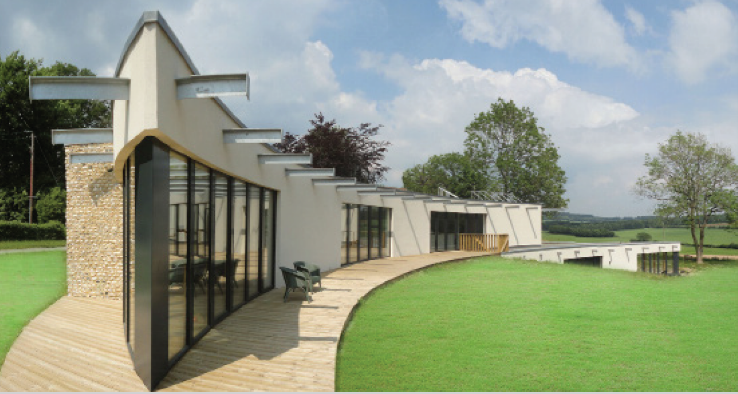

Create a Bank of Drafts to Use for Future Projects
Most ICF manufacturers offer a breadth of product details, best practices, and instructions to simplify your design process. Many have comprehensive online catalogs or design libraries where you can find BIM modeling, PDFs, and DWG drawings for you to download.
The more you work with ICFs, the more your library can grow, saving you time when you need to reference product or project details.
Estimating for ICF Construction

After the initial concept is determined and rough drafts are complete, an estimate will determine budgets allocated for the materials. Typical areas that are well suited for ICF construction are: exterior walls including below/above grade and parapet (black), demising walls (red), corridors walls (blue), elevators shaft and stairwells (green). It is standard practice that partition walls are not constructed using ICF due to their likelihood of being moved in the future as part of a remodel.
Once you have identified the walls designated as ICF construction, an estimate can be established by using the following example as a guideline. This outlines the process for an exterior wall, but is also applicable to other wall types. Straight forms and corner forms can be determined separately for a more precise price breakdown.
Determining Gross and Net Value
- To calculate the form, count for a particular wall section, it is suggested to separate the estimate either per level or per item (i.e., total exterior wall or exterior for level 1 only), ICF core sizes (i.e., 6”, 8”, etc..) and ICF types (i.e., standard form, one-side form, or specialty form). For this example, the building’s exterior wall (the black walls in the image above), will be estimated per level.
- The first step of the estimate is to determine the Gross Wall Surface Area. This can be calculated by multiplying total linear feet of the building wall segment by the total wall height used in the building for that wall segment. This estimate can be used in establishing a budgetary cost for that wall segment. This number will be approximate because it will not take any window or door openings account. This value will not separate the forms into straight forms or corner forms. This can be done by calculating the total amount of corners per row needed, then multiplying by the number row required for the total height needed for that wall segment. This value will determine the total number of corners required.
- To calculate the number of straight forms needed, take the total surface area of the corner forms and substrate it from the total Gross Surface area then divide it by the surface area of a single straight form. This value will be the total number of straight forms required. To get the net value of ICF block quantities, subtract the surface area of the openings. It's always a good idea to add a small percentage to this to accommodate for waste that may occur throughout the construction process.
- To determine the Net Surface Area, all the openings located in the wall segment will need to be calculated and then removed from the Gross Wall Surface Area. This value can be removed from the total amount of straight forms as openings are typically located between corner forms (but this is a specific exercise that must be determined on a per project basis).
- If available, take advantage of the manufacturer’s estimating services to ease these calculations (left side of the image below). Using product-specific dimensions, you can also create your own Excel tool to match your specific project details (right side of the image below). If you are still missing data for your estimates, contact your manufacturer to help you find the information you need.
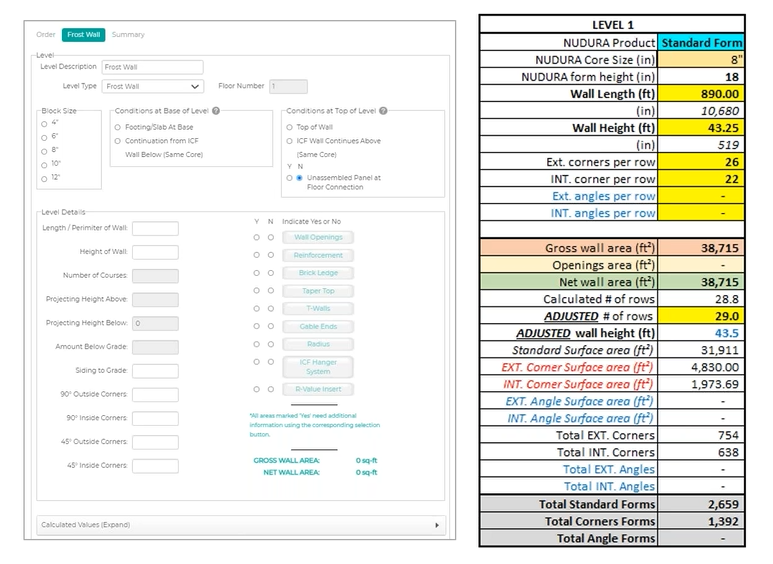
Associated Products Involved in ICF Construction
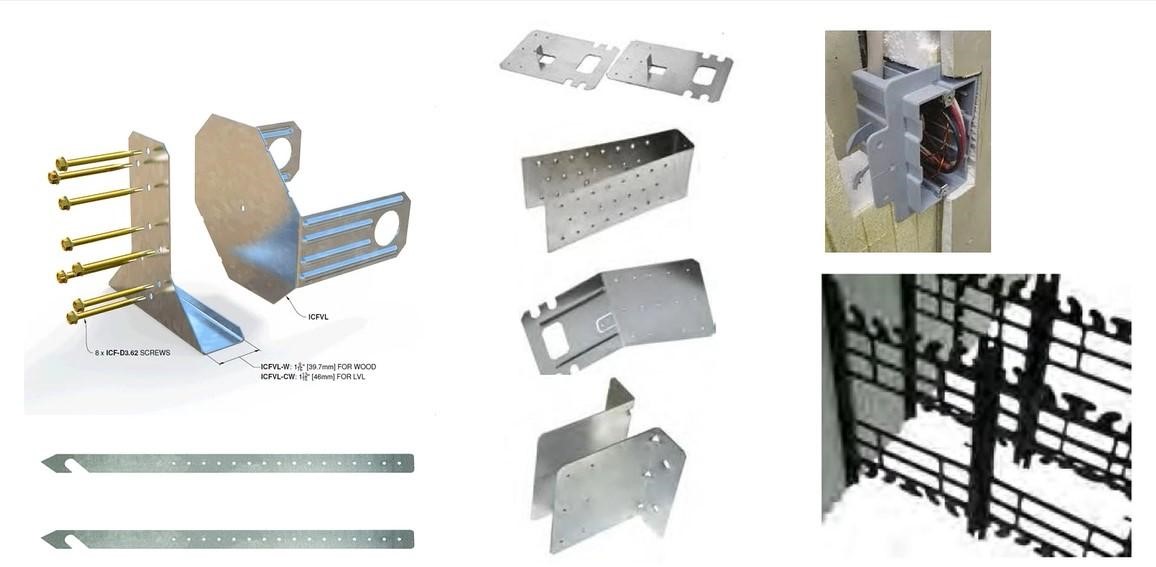
There are many accessory products used for ICF construction to secure flooring systems, attach roof truss, create T-Intersections, and widen available core sizes. Going from left to right in the above image are:
- Proprietary ICFVL brackets which are often used to attach ledger boards (top left)
- Straps that accommodate for T-intersections (bottom left)
- Metal and mechanical-type fasteners (center)
- Electrical boxes specifically made for ICF construction (top right)
- Adapters to create larger ICF widths if needed (bottom right)
Aside from the ICF-specific products, consider the above- and below-grade waterproofing membranes, air and vapor barriers, and sealants needed to protect the building envelope.
ICF Is the Smart Choice for Construction
With a basic understanding of how to prepare for the incorporation of ICFs within a project design, the remaining stages of the design/build process will be much simpler. And from there, once you get your first ICF project under your belt, you’ll see why others are opting for ICF construction to create their highly energy-efficient, safe, and beautiful buildings.
CONTACT US
We’re committed to supporting homeowners and design professionals who are interested in or use our products. We’re always happy to help and provide more information.
